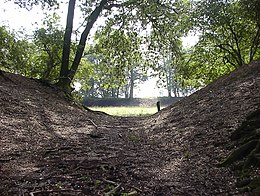Eugeniana fossa
The Fossa Eugeniana is an unfinished canal between the Rhine and the Meuse . Construction began in 1626, the remains that are still visible are being preserved by the monument protection department . Its width is about 4.3 m (as far as can still be determined), its length almost 50 km.
history
During the Spanish-Dutch War , the canal was intended to cut off the breakaway Dutch provinces that were then part of Spain from the profitable trade on the Rhine . No more money should be brought into their war chests.
In a second stage, it was planned to expand the canal up to the Scheldt so that access from the Rhine to the North Sea would have been possible without using the lower section of the Rhine. There were even considerations of moving the entire Rhine into a new bed in order to make the ports of Amsterdam and Rotterdam insignificant.
From the beginning, the canal was also intended as a defensive wall for the Spaniards against the Dutch, and so 24 bastioned entrenchments were built at regular intervals . However, the protection was insufficient, and after several, partly successful raids by the Dutch, the almost complete construction was abandoned.
The canal was planned under the then Spanish regent in Brussels , Isabella Clara Eugenia , daughter of Philip II of Spain , after whom it was also named. The technical management was probably in the hands of Giovanni di Medici, also involved (possibly for military protection?) Was the Marquis Spinola .
Under the direction of the then governor of the Upper District of Geldern , Heinrich von dem Bergh , construction began with great enthusiasm. The groundbreaking ceremony took place on September 21, 1626. Soon up to 8,000 workers were at work. The jumps were already raised in November and the canal from Rheinberg to Geldern was so far that it led to water.
Isabella Clara Eugenia arrived in Roermond on June 17, 1627 in order to visit the course of the Fossa Eugeniana from Venlo via Straelen to Geldern over the next few days .
Difficulties arose during the construction of the second half. Technical problems, the already mentioned raids by the Dutch troops, and financial problems of the Spanish crown, to which the capture of the silver fleet in 1628 contributed, caused the project to stall. In 1629 the work was temporarily stopped.
At the latest with the capture of Venlo in 1632 and Rheinberg in 1633 by the Dutch under Friedrich Heinrich , the original reason for the construction of the Fossa Eugeniana no longer existed.
Course of the Eugenian fossa
At Rheinberg the canal begins or ends in the Rhine ( ⊙ ), from there it runs north of Kamp-Lintfort , past the Kamp monastery between Sevelen and Issum towards Geldern . Then it leads south past Walbeck (there it still carries water and is called Grift ), where the canal course then bends south between Arcen (Netherlands) and Straelen . It flows into the Meuse near Venlo ( ⊙ )
Large parts of the course of the Fossa Eugeniana are still clearly visible today. Some of the jumps are also still visible, especially on the section between Geldern and Rheinberg. This makes the complex an important ground monument between Germany and the Netherlands .
A 60 km long cross-border path for hikers, cyclists and skaters was established along the Fossa Eugeniana at the end of the 1990s, which also leads past other attractions in the area.
See also
literature
- Wolfgang Dassel & Robert Plötz: Fossa Eugeniana: World history in the region (Kevelaer, 1997).
- Rolf-Günter Pistor & Henri Smeets: The Fossa Eugeniana: An unfinished canal connection between the Rhine and the Maas, 1626. Rhineland State Conservator, Arbeitshefte 32, Rheinland-Verlag (Cologne, 1979).
- Jonathan Israel: 'A Spanish project to defeat the Dutch without fighting: The Rhine-Maas canal, 1624-9', chapter 3 in: Conflicts of empires: Spain, the Low Countries and the struggle for world supremacy, 1585-1713 (London , 1997).
- Roel Zijlmans: 'Plannen voor Schelde-Maas-Rijnverbindingen, 16e-18e eeuw', Chapter 5 in: Troebele betrekkingen: Grens-, scheepvaart- en waterstaatskwesties in de Nederlanden tot 1800 (Hilversum, 2017, ISBN 978-90-8704-637 -8 ).
Web links
- Description of this sight on the route of industrial culture
- City of Kamp-Lintfort to the Fossa with a historical map of the course
- Radiological contamination of the Eugeniana fossa from coal mining (PDF file; 154 kB)
- Research hit on the Fossa Eugeniana in the Kleve district archive in Geldern
- Common tourism website of the cities of Geldern, Straelen and Venlo to the area of the Fossa Eugeniana




